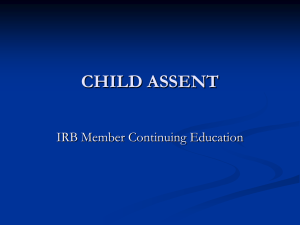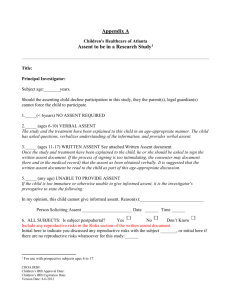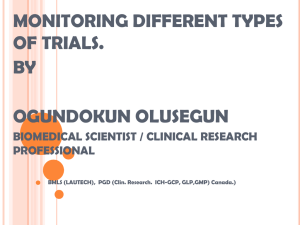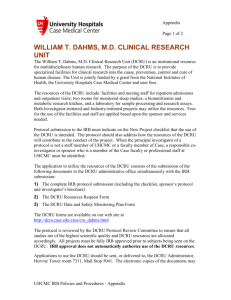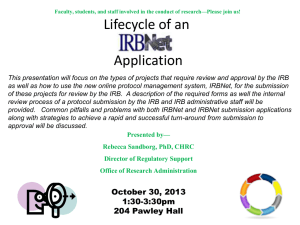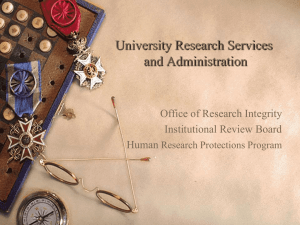A PEDIATRIC RESEARCH "ASSENT" DECISION MATRIX
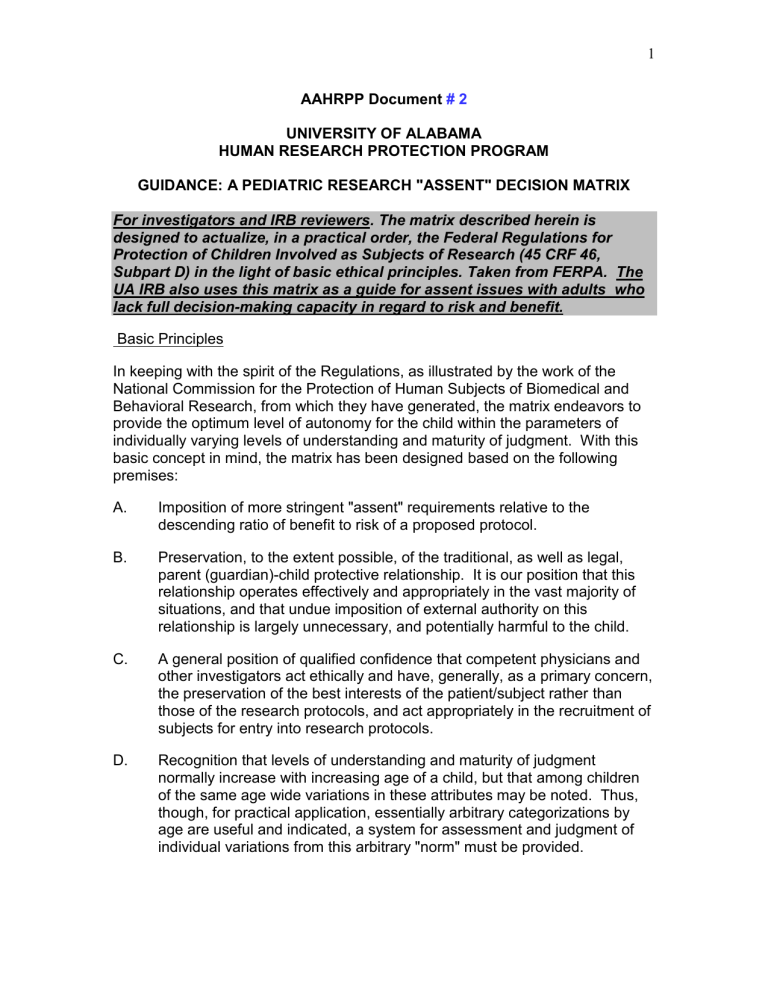
AAHRPP Document # 2
UNIVERSITY OF ALABAMA
HUMAN RESEARCH PROTECTION PROGRAM
GUIDANCE: A PEDIATRIC RESEARCH "ASSENT" DECISION MATRIX
For investigators and IRB reviewers. The matrix described herein is designed to actualize, in a practical order, the Federal Regulations for
Protection of Children Involved as Subjects of Research (45 CRF 46,
Subpart D) in the light of basic ethical principles. Taken from FERPA. The
UA IRB also uses this matrix as a guide for assent issues with adults who lack full decision-making capacity in regard to risk and benefit.
1
Basic Principles
In keeping with the spirit of the Regulations, as illustrated by the work of the
National Commission for the Protection of Human Subjects of Biomedical and
Behavioral Research, from which they have generated, the matrix endeavors to provide the optimum level of autonomy for the child within the parameters of individually varying levels of understanding and maturity of judgment. With this basic concept in mind, the matrix has been designed based on the following premises:
A. Imposition of more stringent "assent" requirements relative to the descending ratio of benefit to risk of a proposed protocol.
B. Preservation, to the extent possible, of the traditional, as well as legal, parent (guardian)-child protective relationship. It is our position that this relationship operates effectively and appropriately in the vast majority of situations, and that undue imposition of external authority on this relationship is largely unnecessary, and potentially harmful to the child.
C. A general position of qualified confidence that competent physicians and other investigators act ethically and have, generally, as a primary concern, the preservation of the best interests of the patient/subject rather than those of the research protocols, and act appropriately in the recruitment of subjects for entry into research protocols.
D. Recognition that levels of understanding and maturity of judgment normally increase with increasing age of a child, but that among children of the same age wide variations in these attributes may be noted. Thus, though, for practical application, essentially arbitrary categorizations by age are useful and indicated, a system for assessment and judgment of individual variations from this arbitrary "norm" must be provided.
E. Recognition that situations may arise in which levels of maturity of subjects, appropriate exercise of the protective role of parents, goodwill and ethical actions of investigators and/or uncertainty as to the relationship of benefits to risks, are called into question and which require the imposition of a competent, knowledgeable professional third party into the process as an informed witness to the process on behalf of the Institutional Review Board with responsibility to advise the Board in cases in which failure to adhere to policy is perceived.
2
F. Recognition that the Institutional Review Board has the ultimate responsibility for review, approval and for continuing oversight of all human subjects research taking place within the institution, and for assuring continuous compliance with ethical research practice and with the Regulations.
Structure and Interpretation of the Matrix
The matrix is based on the relationship between benefit vs. Risk ratio and the age of the subject, each division indicating the appropriate requirements for determining the eligibility of the subject for entry into the protocol or project. The matrix is arranged in descending order of ratio of benefits to risk as defined in
Subpart D, and the age potential for assent by child subjects, from upper left to lower right divisions. For convenience, the matrix has been referenced alphabetically for each category of risk, and by roman numerals for each group by age. The terms and definitions used and the requirements established are further explained and amplified in the footnotes to the matrix.
CATEGORY
G
R Age
O
U
P
<8
8-12
A
NOT GREATER
THAN
MINIMAL RISK
46.404
Committee (IRB) approval of project
Parental (one) permission required a
Assent not required
Committee (IRB) approval of project
Parental (one) permission required a
Assent suggested where reasonably
CHILDREN AS SUBJECTS OF RESEARCH
45 CFR 46
B.
GREATER
C.
GREATER THAN
THAN MINIMAL
RISK
MINIMAL RISK
NO DIRECT BENEFIT,
D.
RESEARCH NOT OTHERWISE
APPROVED PRESENTING
OPPORTUNITY TO UNDERSTAND,
WITH DIRECT
BENEFIT
TO SUBJECT
46.405
BUT
BENEFIT TO
UNDERSTANDING
OF SUBJECT'S
DISORDER
46.406
PREVENT OR ALLEVIATE
SERIOUS PROBLEM AFFECTING
CHILDREN
46.407
Committee (IRB) approval of project
Parental (one) permission required a
Assent not required
Minor increase over minimum risk
Committee (IRB) approval of project
Witnessed parental permission of both parents required e
Witnessed assent suggested where reasonably possible f
HHS approval
Committee (IRB) approval of project
Witnessed parental permission of both parents required e
Witnessed assent suggested where reasonably possible f
Committee (IRB) approval of project
Parental (one) permission required a
Assent strongly suggested where reasonably
Minor increase over minimum risk
Committee (IRB) approval of project
Witnessed parental permission of both parents required e
Witnessed assent required
HHS approval
Committee (IRB) approval of project
Witnessed parental permission of both parents required e
Witnessed assent required where possible g
Individual exception may be sought
3
>13 possible b
Committee (IRB) approval of project
Parental (one) permission required a
Assent required
Individual exceptions may b sought c possible b
Committee (IRB) approval of project
Parental (one) permission required a
Assent required
Individual exceptions may be sought c where possible g
Individual exception may be sought
Minor increase over minimum risk
Committee (IRB) approval of project
Witnessed parental permission both parents required
Witnessed assent required apart from parents if necessary h
HHS approval
Committee (IRB) approval of project
Witnessed parental permission of both parents required e
Witnessed assent required apart from parents if necessary h
General Procedural Requirements and Definitions
1. It is the responsibility of the investigator to advise the parent(s) of potential child subjects of the existence of and the provisions of this policy and procedure, and also that further information is available from the Committee of Protection of
Human Subjects (IRB) through the Research Director's office.
2. Parental "permission" is always required for minors' participation in research.
Overriding of parental objection to participation in a project which, in the investigator's opinion, may be harmful to the proposed subject by reason of lack of participation in the project requires action of the appropriate civil court. Social
Service consultation, with the knowledge of the Research Director, should be sought should such a situation arise.
3. Witnesses: persons selected to witness assent activity, as required in this policy, must be qualified health professionals who are aware of: a) this policy and procedure; b) their professional responsibility to assure that assent is appropriately obtained; and c) their responsibility to seek the counsel of the
Committee on Protection of Human Subjects (IRB) through the Research
Director's office should any questions or concerns regarding propriety or procedure arise. It is the responsibility of the investigator to assure that the witness is advised of the above requirement.
FOOTNOTES: a. Permission of either parent is sufficient. Legal guardian is accepted in lieu of parent. b. Determination of reasonableness may be made jointly by parent and investigator.
Disagreements should be referred to Committee (IRB) for adjudication. Parent must be made aware of role and provision by investigator. c. Exceptions to assent requirement by reason of lack of maturity of judgment or psychological state of the proposed subject may be requested in specific individual cases by the investigator of the Committee (IRB). Parental permission and agreement to seek exception is required. Contact the Research Director for instructions. d. Determination of reasonableness may be made jointly by parent and investigator.
Doubts should be resolved in favor of assent. Disagreements should be referred
4 to the Committee (IRB) for adjudication. It is the investigator's obligation to make these provisions known to the parent. e. Permission of both parents, if reasonably available, is required unless only one parent has legal responsibility for care and custody of the proposed subject.
Legal guardian is acceptable in lieu of parent(s). A qualified witness (3 above) must observe both "permission" and "assent" solicitation and response. It is the investigator's responsibility to make these provisions known to the parent(s) and witness. f. Determination of reasonableness should be made jointly by parent(s) and investigator in the presence of a qualified witness (3 above). Disagreement by any of the aforementioned persons excludes the proposed subject from study. g. Where assent is not deemed possible in the opinion of parents, investigator and/or qualified witness, exception must be sought on an individual basis from the Committee (IRB). Contact the Research Director for instructions. h. If parents are deemed by investigator or qualified witness to bring undue influence to bear on the proposed subject to make a specific decision, assent may be sought outside the parents' presence but in the presence of the qualified witness (3 above).
